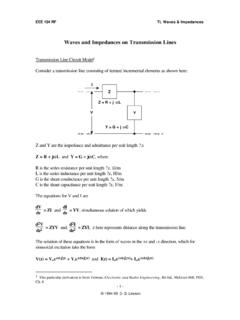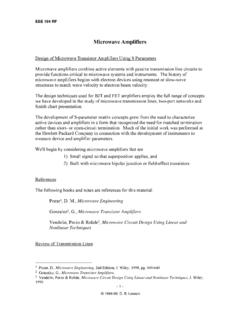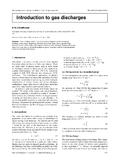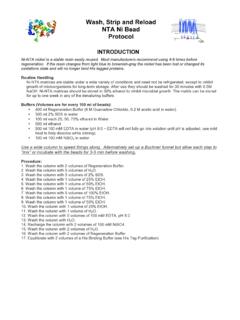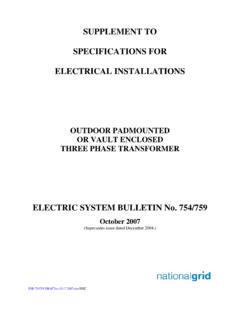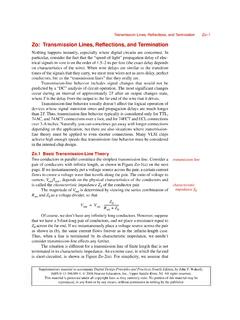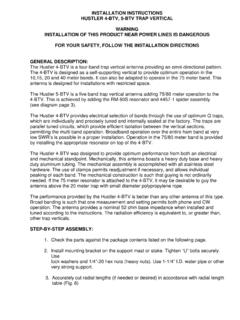Transcription of S-Parameter Matrices
1 EEE 194 RF S-Parameter Matrices - 1 - 1994-99 D. B. Leeson S-Parameter Matrices The objective of microwave circuit analysis is to move from the requirement to solve for all the fields and waves of a structure to an equivalent circuit that is amenable to all the tools of the circuit analysis toolbox. However, the tools that are appropriate for lumped circuits must be extended to apply to distributed networks. A matrix that is of great use in microwave network problems is the "scattering" matrix, so-called by analogy to the scattering or reflection of waves by a free-space reflector. As introduced in the prior notes, S- parameters have become the preferred description of microwave n-ports for the following reasons: Voltage and current are difficult to define and measure in distributed circuits The measurement of power in incident and reflected waves is a natural technique for microwave transmission lines. Voltage and current may not be well defined, or even defined at all, in some structures.
2 The specification of voltage and current in a distributed circuit requires a specification of the exact location, and these parameters vary with location in the circuit. The determination of the individual parameters of voltage and current equation sets requires short or open circuit loads, which are sensitive to the precise location; in particular, it is not practical to mount a connector close enough to a microwave lumped device to be measuring its actual port voltages and currents. Also, many active devices cannot be operated with fully reflective terminations (short or open) of arbitrary phase, as they will oscillate, which is a large signal nonlinear condition and may even result in device failure. Incident and reflected waves are the natural description for microwave structures The matched condition ( = 0) is a unique, repeatable termination . It is insensitive to the length of transmission line to the matched load, so that measurements can be made without requiring the reference planes (the port connectors) to be located directly at the device under measurement (or being described).
3 A matched load is a natural structure that can maintain its character over a very broad frequency range. Conversion from S- parameters to other parameter sets is a matter of routine algebra Each of the many equivalent parameter sets is uniquely useful for a given circuit topology. For example, the ABCD and T Matrices are adept at cascaded networks, while the Z and Y parameter sets can be directly evaluated for tee and pi networks, respectively. However, the conversion process, while complex appearing, lends itself to repeated routines for hand or computer calculation. EEE 194 RF S-Parameter Matrices - 2 - S- parameters (in fact, all the parameter sets) benefit from the matrix toolbox. The toolbox of established matrix mathematics is directly applicable to the Matrices that are the equivalent of the port equations of the parameter sets. For example, the S matrix can be inspected for lossless, reciprocal or unilateral character. If either or both of these conditions is present, many of the individual matrix elements can be determined by inspection.
4 Equivalence of Matrix and Equation Form For a single port network, we have the following simple relationships from our study of and Smith chart. b1 = a1 = S11a1 b1 = a1 = S11a1 For a multiport network the reflection coefficient is defined as bn = nan, so n = bnan where n is the port number. Note that n = Snn only if all other ports are terminated, that is, only if all am = 0 for m?n. Otherwise it must be algebraically calculated from all the parameters . The example of 2-port equations and their equivalent matrix is shown here to emphasize that both forms contain the same information, but the matrix form suggests the use of formal matrix algebra tools as an aid to analysis: b1b2 =S11 S12S21 S22 a1a2 b1 = S11a1 + S12a2 b2 = S21a1 + S22a2 It is not uncommon to consider microwave networks of three and four ports, as in power dividers and directional couplers. The extension to the example of 3-port equations and equivalent matrix should reinforce the concept of equivalence: b1b2b3 =S11 S12 S13S21 S22 S23S31 S32 S33 a1a2a3 b1 = S11a1 + S12a2 + S13a3 b2 = S21a1 + S22a2 + S23a3 b3 = S31a1 + S32a2 + S33a3 Using matrix rules we can inspect an S-Parameter matrix and see whether the network is reciprocal and whether it is lossless.
5 We can then use these facts to reduce the number of independent variables in the matrix, so that we can more easily evaluate the matrix elements (the parameters of the equations). EEE 194 RF S-Parameter Matrices - 3 - Which Matrices Are Used When? We've seen that the equations and related matrix expressions all involve various combinations of an, bn, Vn, and In. Certain of the forms are more easily evaluated in specific network topologies. For example, suppose the network is composed of impedances as here ZaZbZc12 If we considering the impedance at port one for an open-circuited port 2, we see that Z11 = Za + Zb and similarly Z22 = Zc + Zb . If we apply input current I1 the open circuit output voltage is I1Zb, so Z12 = Zb,. Solving for Z11, Z12 and Z22 we find Z11 - Z12 = Za Z22 - Z12 = Zc and Z12 = Z21 = Zb This defines the parameters of the Z matrix description [V] = [Z][I] V1 = Z11 I1 + Z12 I2 V2 = Z21 I1 + Z22 I2 The T network lends itself to the Z matrix description, which can then be converted to the equivalent S matrix for S-Parameter measurements and operations.
6 Now consider the p form of a network, shown here: EEE 194 RF S-Parameter Matrices - 4 - YaYbYc12 If we consider the admittance at port 1 for shorted port 2, we see that for this network Y11 + Y12 = Ya; similarly Y22 + Y12 = Yc and Y12 = -Yb [I] = [Y][V] I1 = Y11 V1 + Y12 V2 I2 = Y21 V1 + Y22 V2 Now consider the application of the ABCD matrix. The fact that the output voltage and current of the first of two cascaded networks are equal to the input voltage and the negative of the input current, respectively, of the second network makes the ABCD matrix a natural choice because is explicitly deals with the parameters Vn and In. V1 = A V2 + B I2 I1 = C V2 + D I2 [ABCD][ABCD] So by matrix multiplication, we can find the ABCD description of cascaded networks. A last consideration is the question of a shift in reference planes, which is handled well by the S matrix. If we ask for the S matrix description of the following network [S]Zo, 1Zo, 2 EEE 194 RF S-Parameter Matrices - 5 - we find that it is simply [S'] = [ 1][S][ 2], where [ n] is defined such that all terms are zero except the diagonal terms, which are e-j2 n.
7 Useful Matrix Operations Certain simple matrix operations are useful in manipulating and evaluating S-Parameter Matrices . They include Multiplication (cascade ABCD or shift of reference plane Test for reciprocity Test for losslessness Test for unilateral transmission Multiplication of Matrices can be used to determine the ABCD or S parameters of cascaded networks of simpler forms. The test for reciprocity requires that the matrix be symmetric, that is Smn=Snm. This can generally be determined by inspection. The test for losslessness is that the sum of the SmnSmn* of any column must be unity. If the network is reciprocal, the matrix is symmetric and the same can be said of any row. The test for unilateral transmission is that S12 = 0. ABCD Example: Quarter- and Half-Wave Transmission Lines The usefulness of ABCD parameters can be seen in an example that has been the subject of a homework problem. Consider a transmission line of length l.)
8 ZLZolV1I2 The ABCD parameters of this network relate Vi and Ii, such that V1 = A V2 + B I2, and I1 = C V2 + D I2. EEE 194 RF S-Parameter Matrices - 6 - The ABCD matrix of a length of transmission line l of Zo and is A = cos l B = j Zo sin l C = j Yo sin l D = cos l Note that, for cos l = 0 (that is, for l=p/2, a quarter wavelength or odd multiple) the ABCD matrix becomes simply A = 0 B = j Zo C = j Yo D = 0 which implies that I2 = V1/j Zo independent of V2 or I1. The fact that the output current depends only upon the input voltage and the characteristic impedance (regardless of the load impedance) is useful to construct feed structures for phased antennas, in which the element currents are the key parameters . If it desired to control the currents of several loads of varying impedance, each can be fed through identical quarter-wave lines that are paralleled at their inputs, thus insuring that, since they all have the same V1 they all have the same I2.
9 Similarly, if sin l = 0 (that is, for l=p, a half wavelength or multiple) the ABCD matrix becomes simply A = -1 B = 0 C = 0 D = -1 which implies that V2 = -V1 and I2 = -I1 independent of the terminating impedance at end 2. Review of Transmission Lines For the purpose of characterizing microwave multiport networks, key transmission line concepts are 1) Traveling waves in both directions, V+ and V- 2) Characteristic impedance Zo and propagation constant j 3) Reflection coefficient =ZL - ZoZL + Zo for complex load ZL EEE 194 RF S-Parameter Matrices - 7 - 4) Standing waves resulting from ?0 5) Transformation of ZL through line of Zo and length l 6) Description of and Z on the Smith chart (polar graph of ) Review of Scattering Matrix 1) Normalization with respect to Zo of wave amplitudes: a = V+Zo and b = V-Zo , so power is aa* and bb* 2) Relationship of bn and an: bn = n an 3) Expressions for b1 and b2 at reference planes: b1 = S11a1 + S12a2 b2 = S21a1 + S22a2 4) Definitions of Sii: S11 = b1a1 for a2 = 0, , input for output terminated in Zo.
10 S21 = b2a1 for a2 = 0, , forward transmission ratio with Zo load. S22 = b2a2 for a1 = 0, , output for input terminated in Zo. S21 = b1a2 for a1 = 0, , reverse transmission ratio with Zo source. lS21l2 = Transducer power gain with Zo source and load. 5) Definitions of L, s, in and out: L = ZL - ZoZL + Zo , the reflection coefficient of the load s = Zs - ZoZs + Zo , the reflection coefficient of the source in = Zin - ZoZin + Zo = S11+S12S21 L1-S22 L , the input reflection coefficient out = Zout - ZoZout + Zo = S22+S12S21 s1-S11 s , the output reflection coefficient 6) Power Gain G, Available Gain GA, Transducer Gain GT: G = PLPin = power delivered to the loadpower input to the network EEE 194 RF S-Parameter Matrices - 8 - GA = PavoutPavs = power available from the networkpower available from the source GT = PLPavs = power delivered to the loadpower available from the source Power Gain Equations The equations for the various power gain definitions are 1) G = PLPin = 11 - l inl2 lS21l2 1 - l Ll2l1 - S22 Ll2 2) GA = PavoutPavs = 1 - l sl2l1 - S11 sl2 lS21l2 11 - l outl2 3) GT = PLPavs = 1 - l sl2l1 - in sl2 lS21l2 1 - l Ll2l1 - S22 Ll2 = 1 - l sl2l1 - S11 sl2 lS21l2 1 - l Ll2l1 - out Ll2 The expressions for in and out are 1) in = S11+S12S21 L1-S22 L 2) out = S22+S12S21 s1-S11 s For a unilateral network, S12=0 and 1) in = S11 if S12=0 (unilateral network) 2) out = S22 if S12=0 (unilateral network)
